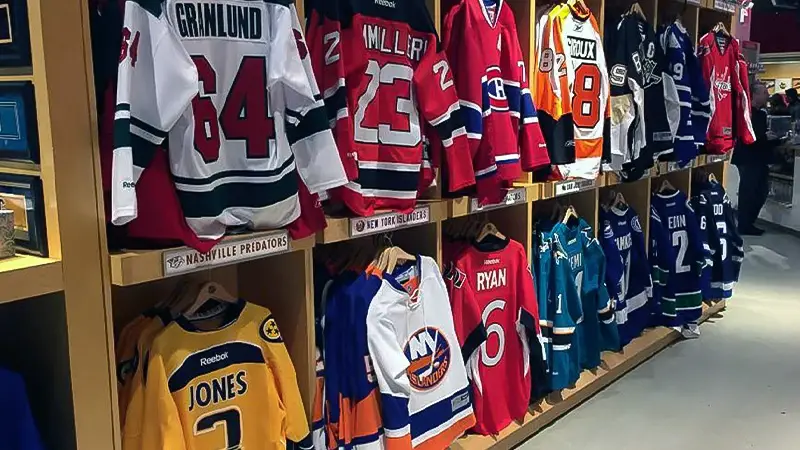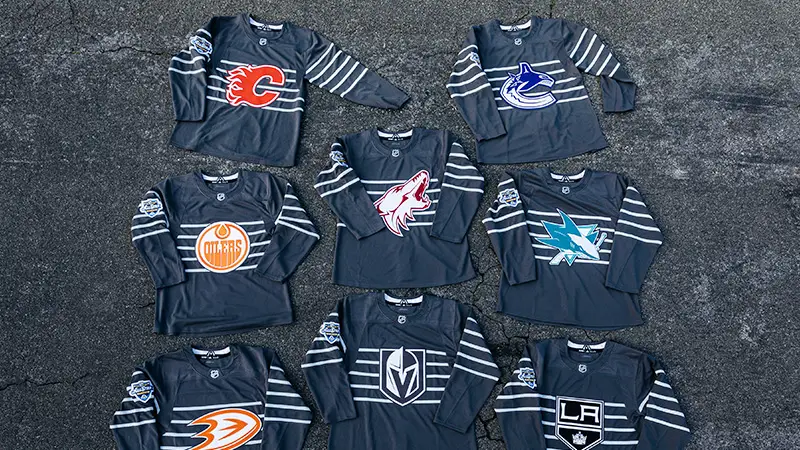In the colorful world of professional sports, where team jerseys are more than just garments, the absence of one particular hue has intrigued many hockey enthusiasts: purple.
While the NHL boasts a vibrant spectrum of jersey colors, from classic reds to bold blues, one might wonder why purple remains a rarity on the ice.
This blog post delves into the intriguing history and design choices behind the conspicuous question on ‘Why don’t any NHL teams have purple jerseys?’.
From the iconic purple-and-gold era of the Los Angeles Kings to occasional purple accents in alternate jerseys, there’s more to this color’s story than meets the eye.
Join us on a journey through the annals of hockey fashion, exploring the factors that have shaped the color palette of NHL teams and why purple, despite its regal charm, hasn’t found a permanent home in the league.

The Importance of Team Colors in Hockey?
Team colors in hockey hold significant importance for several reasons. Firstly, they foster a sense of identity and unity among players and fans.
These colors represent a team’s history, values, and traditions, creating a strong emotional connection.
Secondly, team colors aid in player recognition on the ice, helping teammates make split-second decisions and fans follow the action. Uniformity in colors enhances team cohesion and strategy execution.
Moreover, team colors play a pivotal role in merchandising, as fans proudly wear jerseys and accessories that showcase their allegiance. This generates revenue for teams and the league.
Team colors in hockey are more than just aesthetics; they symbolize pride, teamwork, and the deep bond between a team and its supporters, contributing to the sport’s rich culture and tradition.
Why Don’t Any NHL Teams Have Purple Jerseys?
While several NHL teams have experimented with alternate jersey colors and designs over the years, purple jerseys have been relatively rare in the league. There are several reasons for this:
Tradition and History
The NHL has a long history rooted in traditional team colors.
Many of the original six teams, such as the Montreal Canadiens, Toronto Maple Leafs, and Boston Bruins, have established color schemes that have endured for decades.
Teams often maintain these traditional colors as a way of honoring their history and maintaining a strong connection to their fan base.
Marketing and Branding
Teams invest heavily in branding, and their primary colors become synonymous with their identity.
Changing to a color like purple, which may not be associated with the team’s history or region, can be a risky move from a marketing perspective.
Teams are cautious about altering their brand identity in ways that might not resonate with fans.
Competitive Advantage
Teams often consider the psychological impact of colors on both their players and opponents.
Some teams believe that certain colors, such as red, are associated with aggression and confidence, which may provide a competitive advantage.
Purple, being less common in sports, doesn’t carry the same psychological associations.
Fan Preferences
Teams are sensitive to fan preferences and traditions. Many fans have strong attachments to their team’s existing colors and jerseys.
Changing to purple could alienate some long-time supporters who identify with the current color scheme.
NHL Approval
Any significant changes to a team’s jersey colors require approval from the NHL, which may take into account factors such as league-wide color balance and branding consistency.
While it’s not impossible for an NHL team to introduce purple jerseys in the future, it would likely be done as an alternate or specialty jersey rather than a permanent change.
Teams often use alternate jerseys to experiment with different colors and designs while still maintaining their traditional look for the majority of games.
The Limited History of Purple Jerseys in the NHL

Purple jerseys have had a limited but intriguing history in the NHL. The most notable use of purple jerseys was by the Los Angeles Kings during the 1980s and early 1990s.
The Kings introduced purple and gold jerseys, which were distinctive and garnered attention. This era, often associated with players like Wayne Gretzky, contributed to the popularity of purple in the NHL.
The Kings eventually transitioned away from purple in the mid-1990s, adopting black and silver as their primary colors. Since then, purple jerseys have rarely made appearances.
However, some teams, like the Colorado Avalanche and Minnesota Wild, have occasionally incorporated purple accents into their alternate jerseys.
The NHL’s limited history of purple jerseys is primarily tied to the Los Angeles Kings’ iconic use of the color during a memorable era in the league’s history, making it a unique part of NHL jersey history.
How Tradition Plays a Significant Role in The Design of NHL Jerseys?

Tradition plays a significant role in the design of NHL jerseys, with several key aspects contributing to the importance of heritage and history in the league’s uniform aesthetics:
Team Identity
NHL jerseys serve as a visual embodiment of a team’s identity. Traditional designs are meticulously crafted to encapsulate the essence of a team, often by incorporating specific colors, logos, and elements that have deep-rooted associations with the franchise.
These design choices aren’t arbitrary; they serve to remind fans and players of the team’s historical journey, values, and character.
For instance, the iconic red, white, and blue of the Montreal Canadiens’ jersey represents their French-Canadian heritage and historic ties to the city.
Fan Loyalty
The jerseys are more than just garments; they are symbols of unwavering fan loyalty.
Over the years, fans develop profound emotional connections to their teams, and these jerseys become tangible expressions of that devotion.
Traditional designs have a unique ability to stir nostalgia and evoke a profound sense of belonging among fans who have supported the team for generations.
Wearing a team’s jersey is akin to wearing a badge of honor, signifying allegiance to a cause that transcends generations.
Historical Significance
The historical significance of NHL jerseys cannot be understated. Many NHL teams have storied histories marked by legendary players and unforgettable moments.
Traditional jerseys act as portals to the past, reminding both players and fans of the iconic achievements, thrilling victories, and enduring legacies that define the team’s journey.
Whether it’s the New York Islanders’ four consecutive Stanley Cup championships or the Detroit Red Wings’ “Original Six” heritage, these jerseys encapsulate the stories that have shaped the league’s history.
Iconic Elements
Some NHL jerseys boast iconic elements that have become synonymous with the team’s tradition.
For example, the Montreal Canadiens’ jersey features the iconic “CH” logo, a symbol of their storied history and dominance in the league.
Similarly, the Boston Bruins’ bear emblem is instantly recognizable and carries with it a rich tradition of rugged, physical play.
These symbols transcend mere aesthetics; they are the embodiment of a team’s culture and legacy.
Cultural Heritage
NHL jerseys often incorporate regional or cultural elements that underscore the team’s connection to its community. This serves to not only foster regional pride but also to create a sense of identity among fans.
Whether it’s the Toronto Maple Leafs’ incorporation of the maple leaf or the Minnesota Wild’s nod to the state’s natural beauty, these elements ground the team in its cultural context, forging a deeper bond between the team and its fan base.
Retro Jerseys
The occasional introduction of retro or throwback jerseys is a cherished tradition in the NHL. These designs pay homage to earlier eras of the sport and the teams’ histories.
Fans often revel in the nostalgia of these jerseys, appreciating the league’s commitment to preserving its rich heritage.
The reintroduction of classic designs is met with enthusiasm as it allows fans to relive and celebrate iconic moments from the past.
Team Evolution
While tradition is paramount, NHL teams also recognize the need for evolution and adaptation. Jersey designs are not stagnant but are subject to change, albeit with careful consideration.
When changes are made, they are done with great care to ensure they honor the team’s history and respect the sentiments of the fan base.
Teams may introduce alternate jerseys or modernize their primary designs while retaining core elements that resonate with tradition.
Tradition is the lifeblood of NHL jersey design. It weaves together the stories, and legacies that define the league and its teams, offering fans a tangible connection to the past, present, and future of the sport.
Marketing And Merchandising Aspects of NHL Jerseys
Marketing and merchandising are crucial aspects of NHL jerseys, contributing significantly to the league’s revenue and fan engagement:
Team Branding
NHL jerseys serve as powerful branding tools for teams.
The logos, colors, and designs are instantly recognizable and are used in various marketing materials, from billboards to social media, to create a strong and consistent team image.
Fan Engagement
Jerseys are not just clothing; they are symbols of fan allegiance.
Teams leverage this emotional connection by involving fans in jersey design contests, fan-voted alternates, and limited-edition releases, fostering a sense of ownership and community.
Merchandise Sales
NHL jerseys are among the top-selling sports merchandise globally.
Fans purchase jerseys to show their support, and teams capitalize on this demand by offering a wide range of jersey styles, including home, away, alternate, and specialty jerseys.
Player Endorsements
Star players often have their own jersey lines, and their popularity can boost sales significantly. Teams and the league collaborate with players to market their jerseys and capitalize on their fan base.
Special Events
The NHL creates marketing opportunities around special events like outdoor games, the Winter Classic, and the All-Star Game.
These events often feature unique jerseys that generate excitement and drive merchandise sales.
Jersey Sponsorships
Some NHL teams have started to incorporate jersey sponsorships, similar to European soccer clubs.
This presents additional marketing and revenue opportunities as brands seek to align themselves with popular teams.
Retail Partnerships
Teams collaborate with retail partners to make jerseys readily available to fans, both in physical stores and online. These partnerships expand the reach of NHL merchandise.
Customization
Many fans prefer customized jerseys with their names or favorite players’ names and numbers. Teams offer customization services, generating additional revenue and personalizing the fan experience.
Limited Editions and Collectibles
Teams release limited-edition jerseys and collectibles, creating a sense of urgency and exclusivity that drives sales among collectors and die-hard fans.
Social Media and Digital Marketing
NHL teams and the league use social media and digital marketing to showcase jerseys, share behind-the-scenes content, and engage with fans, creating a digital ecosystem that promotes merchandise sales.
Marketing and merchandising are integral to the success of NHL jerseys, helping teams and the league build their brand, engage fans, and generate revenue through various strategies.
FAQs
Why don’t any NHL teams have purple jerseys?
NHL teams have mostly moved away from purple due to branding and design trends. Teams prioritize colors that align with their identity and resonate with fans.
While purple was prominent in the past, teams have evolved their color schemes to modernize their image and connect with a broader audience.
Did any NHL teams historically use purple jerseys?
Yes, historically, the Los Angeles Kings prominently featured purple jerseys in the 1980s and early 1990s. This era, often associated with Wayne Gretzky, was iconic for purple uniforms.
However, teams’ design preferences have since evolved, leading to a decline in the use of purple.
Are there any exceptions to the absence of purple jerseys in the NHL?
Some NHL teams occasionally incorporate purple accents or use purple as a secondary color in alternate jerseys or special editions.
For example, the Colorado Avalanche and Minnesota Wild have used purple in limited capacities, but it’s not their primary color.
Why do NHL teams prioritize certain colors in their jerseys?
NHL teams prioritize colors that reflect their brand, history, and fan base. Colors often hold deep cultural or regional significance and help create a strong team identity.
Teams choose colors that resonate emotionally with their supporters and enhance their overall image.
Could purple jerseys make a comeback in the NHL?
It’s possible, but unlikely as primary colors. Teams tend to make changes cautiously, preserving their heritage while occasionally introducing alternate jerseys with unique designs or color schemes.
While purple might make sporadic appearances, teams’ primary colors are likely to remain their core brand identity.
Wrapping Up
In the world of NHL jersey design, colors serve as vibrant canvases for team identity and tradition. While purple may not be a dominant force, its sporadic appearances remind us of the league’s dynamic evolution.
Whether it’s a nod to the Kings’ iconic history or a brief foray into alternative aesthetics, the absence of purple jerseys is less about exclusion and more about a deep connection to tradition.
As the NHL continues to innovate and celebrate its rich heritage, who knows when we might witness the resurgence of purple in the world of hockey fashion?
Until then, we’ll continue to celebrate the diverse tapestry of colors that make each team’s jersey a unique and cherished symbol of the sport we love. Thank you so much.







Benjamin Kenyon